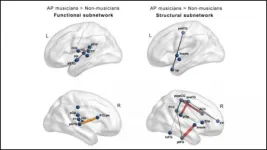(Press-News.org) A survey of dog owners from across the U.S. shows that when it comes to seeking veterinary care for dogs, barriers to access - including a lack of trust - have more effect on the decision-making process than differences in race, gender or socioeconomic status. The results could aid veterinarians in developing outreach strategies for underserved communities.
"I was interested in how different demographic groups viewed health care and how those views might affect relationships between veterinarians and their clients," says Rachel Park, a Ph.D. student at North Carolina State University and first author of a paper describing the work. "The existing literature wasn't national in scope and hadn't accounted for multiple identities held, such as one's socioeconomic status or education, so I saw a knowledge gap that could be filled."
Using Amazon's Mechanical Turk, Park conducted an online survey of 858 self-identified dog owners. Participants were asked to indicate how likely they would be to seek veterinary care under 18 different circumstances. Participants were also asked supplemental questions about their relationship with their dog, previous veterinary behavior and demographic information.
While there was some variance for different medical scenarios, the overall likelihood of dog owners to seek care did not differ significantly across demographics, regardless of race, gender, or socioeconomic status. However, there were demographic differences related to barriers to veterinary care, as well as to the owner's relationship with the dog.
"We did see that women (58.0%), white (48.9%) and Asian (64.4%) dog owners were more likely to describe the dog as a member of the family, rather than as property, whereas some Black (24.4%) or Native American (25.0%) dog owners were more likely to consider the dog property," says Park. "But the difference in the way the relationship was described didn't carry over into a difference in likelihood to seek veterinary care."
The primary barriers to care that respondents identified were transportation, veterinary office hours of operation, cost, language differences and trust. Cost was a bigger factor for dog owners under 29 years old or households making less than $60,000 per year. However, these barriers - with the exception of trust - cut across all demographics: race, gender, education level and socioeconomic status.
Black and Native American respondents were about 10 to 15% more likely to indicate a lack of trust as a barrier to seeking veterinary care.
"This was the most interesting finding," Park says. "Respondents had the ability to select 'had a bad prior experience with veterinarian' as an option, but those who indicated lack of trust didn't choose that as the reason. Research has long reported that racial and ethnic minorities often experience mistrust in health professionals in human medicine and consequently seek health care at a lower rate. Our findings reveal that Black and Native American dog owners experience a similar mistrust in veterinary medicine. This appears to be an important avenue for future research."
While there are limitations to the survey - no statistical weighting to adjust for over- or under-sampling - Park says that the results are still useful for identifying opportunities for outreach from the veterinary community.
"I'm hopeful that this study can help us better understand the barriers different communities face," Park says. "Everyone wants to do what's best for their dog, so the veterinary community has the opportunity to help ensure equal access to care and try and ease those barriers."
INFORMATION:
The research appears in Veterinary Sciences and was coauthored by Margaret Gruen, assistant professor of behavioral medicine, and Kenneth Royal, associate professor of educational outcomes, both at NC State.
-peake-
Note to editors: An abstract follows.
"Association between Dog Owner Demographics and Decision to Seek Veterinary Care"
DOI: 10.3390/vetsci8010007
Authors: Rachel Park, Margaret Gruen, Kenneth Royal, NC State University
Published: Online Jan. 5, 2021 in Veterinary Sciences
Abstract:
(1) Background: An important aspect of dog ownership is providing veterinary care. However, features of dog ownership differ across demographic groups and these may influence veterinary client decision making and behavior. The purpose of the present study was to elucidate relationships between American dog owner characteristics and willingness to seek veterinary care. (2) Methods: A total of 858 dog owners completed an online questionnaire asking participants to rate their level of likelihood to seek veterinary care for different medical conditions, answer supplemental questions about their previous veterinary barriers, and indicate barriers that prevent them from seeking veterinary care. (3) Results: Dog owners did not differ by demographics in their willingness to seek veterinary care. However, dog owner demographic groups varied in their relationship with their dog(s), previous behaviors accessing veterinary care, and barriers that make seeking veterinary care challenging. (4) Conclusions: Education, outreach and community-based veterinary medicine efforts should allocate resources to underserved communities identified within the context that they are affected by barriers to obtaining veterinary care for their dog(s).
In the past 20 years, humans have suffered several serious epidemics from emerging viruses, such as SARS, swine flu, Ebola, MERS and (most recently) SARS-CoV-2. During each epidemic, an accurate, rapid, and accessible molecular diagnostic test is highly essential for the control and prevention of viral diseases. In particular, coronavirus disease 2019 (COVID-19) is spreading rapidly in most countries, resulting in a severe global pandemic, which has a profound impact on the world economy and people's normal life. Accurate and rapid diagnosis of COVID-19 has been the most crucial measure for controlling the ...
FINDINGS
A study led by researchers at the UCLA Jonsson Comprehensive Cancer Center found shortening a traditional 45-day course of radiation to a five-day course delivered in larger doses is safe and as effective as conventional radiation for men with high-risk forms of prostate cancer.
The findings show the five-day regimen of stereotactic body radiotherapy, a form of external beam radiation therapy that uses a higher dose of radiation, had a four-year cure rate of 82%. Severe side effects were also rare. Around 2% experienced urinary issues and less than 1% had bowel side effects.
BACKGROUND
Building on previous UCLA research that provided significant evidence that a shortened regimen of radiation could be ...
(Boston)--Atrial fibrillation (AF) is associated with a higher risk of complications including ischemic stroke, cognitive decline, heart failure, myocardial infarction and death. AF frequently is undetected until complications such as stroke or heart failure occur.
While the public and clinicians have an intense interest in detecting AF earlier, the most appropriate strategies to detect undiagnosed AF and medical prognosis and therapeutic implications of AF detected by screening are uncertain.
A new report led by Boston University School of Medicine (BUSM) researcher Emelia J. Benjamin, MD, ScM, builds upon a recently conducted National Heart, Lung, and Blood Institute's virtual workshop that focused on identifying key research priorities related to AF screening.
Global experts reviewed ...
The brains of musicians have stronger structural and functional connections compared to those of non-musicians, regardless of innate pitch ability, according to new research from JNeurosci.
Years of musical training shape the brain in dramatic ways. A minority of musicians -- with Mozart and Michael Jackson in their ranks -- also possess absolute pitch, the ability to identify a tone without a reference. But, it remains unclear how this ability impacts the brain.
In the biggest sample to date, Leipold et al. compared the brains of professional musicians, some with absolute pitch and some without, to non-musicians. To the team's surprise, there were no strong differences ...
An extensive review of cephalopod fauna from the Northwest African Atlantic coast was performed by researchers from the University of Vigo (Spain) and the Spanish Institute of Oceanography ( END ...
A team led by plant biologists at the Universities of Freiburg and Göttingen in Germany has shown for the first time that mosses have a mechanism to protect them against cold that was previously known only in flowering plants. Professor Ralf Reski at the Cluster of Excellence Centre for Integrative Biological Signalling Studies (CIBSS) at the University of Freiburg and Professor Ivo Feussner at the Center for Molecular Biosciences (GZMB) at the University of Göttingen have also demonstrated that this mechanism has an evolutionarily independent origin - mosses and flowering ...
Every living organism has DNA, and every living organism engages in DNA replication, the process by which DNA makes an exact copy of itself during cell division. While it's a tried-and-true process, problems can arise.
Break-induced replication (BIR) is a way to solve those problems. In humans, it is employed chiefly to repair breaks in DNA that cannot be fixed otherwise. Yet BIR itself, through its repairs to DNA and how it conducts those repairs, can introduce or cause genomic rearrangements and mutations contributing to cancer development.
"It's kind of a double-edged sword," says Anna Malkova, professor in the Department of Biology at the University of Iowa, who has studied ...
Quantum physics allows to make statements about the behaviour of a wide variety of many-particle systems at the atomic level, from salt crystals to neutron stars. In quantum systems, many parameters do not have concrete values, but are distributed over various values with certain probabilities. Often this distribution takes the form of a simple Gaussian bell curve that is encountered also in classical systems for example the distribution of balls in the Galton box experiment. However, not all quantum systems follow this simple behavior and some might deviate from the Gaussian distribution due to interactions.
Prof. Dr. Jens Eisert, who heads a joint research group on theoretical physics at the Freie Universität Berlin and the Helmholtz-Zentrum Berlin, argues that once interactions ...
COLUMBUS, Ohio - Employees feel significantly less job distress if they work at companies that are open and transparent about the firm's finances, including budgets and profits, a new study found.
Researchers examining data from the U.K. found that at companies with more financial transparency, workers felt more secure in their jobs, more committed to their employers and - most significantly - said they had better relationships with their managers.
The link between greater transparency and lower job distress was strong and stood up even after accounting ...
January 25, 2021 - What care do veterans need when recovering after suicide attempts? The answer may be different for women compared to men veterans, reports a qualitative study in Medical Care, part of a special issue devoted to new research on suicide risk and prevention in women. The journal is published in the Lippincott portfolio by Wolters Kluwer.
"The paths to recovery after a suicide attempt may vary by gender, especially among veterans," according to the new research by Lauren M. Denneson, PhD, of the HSR&D Center to Improve Veteran Involvement in Care (CIVIC) at VA Portland (Ore.) Health Care System. "Our data suggest that women emphasize relatedness whereas men emphasize competence." ...





